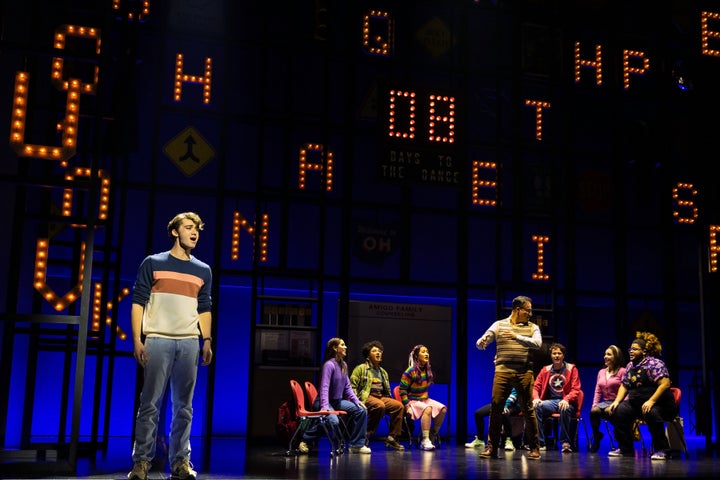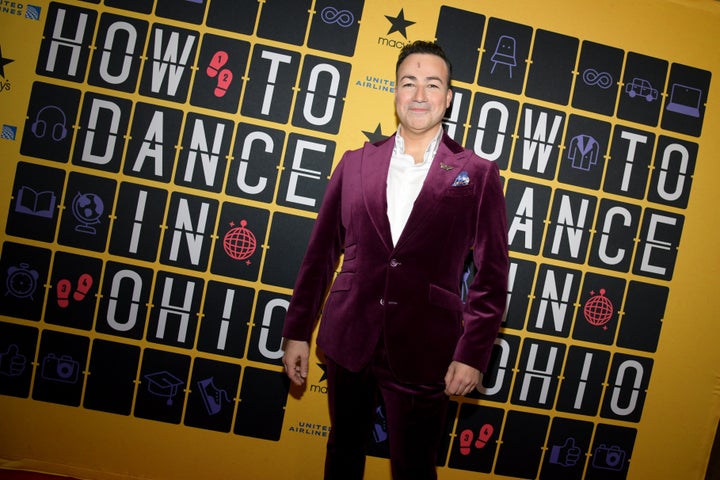“How to Dance in Ohio” may not have enjoyed the blockbuster Broadway run its creators might have hoped for, but actor Caesar Samayoa believes the musical’s impact will be felt within New York’s theater industry for years to come.
“After the pandemic, accessibility and representation moved to the forefront of this industry, and this show is walking the walk,” Samayoa told HuffPost. “We’re going into a divisive year, and I think a lot of people are nervous about what’s to come. We need to be uplifted by human stories at this point. At our core, I think we all want to help each other move forward in life, and that’s the message of this story.”
Based on the 2015 HBO documentary of the same name, “How to Dance in Ohio” opened at New York’s Belasco Theatre in December. The show tells the story of Dr. Emilio Amigo (played by Samayoa), a clinical psychologist who runs a counseling center for young autistic people in the Buckeye State.

To encourage his clients to take their next steps toward independence and social engagement, Dr. Amigo decides to plan a formal spring dance. Unforeseen challenges ensue, however, when the event is thrust into the media spotlight.
“How to Dance in Ohio” boasts an infectious pop-rock score by Rebekah Greer Melocik and Jacob Yandura that’s been compared favorably to the scores of Tony winners like “Dear Evan Hansen” and “Kimberly Akimbo.” Much of the buzz on the show, however, has emphasized its groundbreaking cast. The seven autistic characters are played by actors Desmond Luis Edwards, Amelia Fei, Madison Kopec, Liam Pearce, Imani Russell, Conor Tague and Ashley Wool, each of whom is on the autism spectrum in real life.
“We have a habit of having neurodivergent characters in a story to be the ones who aren’t communicating,” Samayoa said. “But it was a conscious decision that, in our show, the neurotypical character is the one who doesn’t understand the situation. Nobody’s perfect, whether you’re a doctor or not. We wanted to focus on autistic joy.”

A New York native, Samayoa is best known for his breakout performance in the smash 2017 musical “Come From Away.” In fact, he was still appearing in “Come From Away” when he was approached by Greer Melocik to take part in early reading of “How to Dance in Ohio,” which was set to be directed by 21-time Tony winner Harold Prince.
Given his commitment to “Come From Away,” Samayoa had to opt out of the reading. After Prince died in 2019, Broadway newcomer Sammi Cannold stepped in to direct the show. Last summer, Samayoa appeared in Cannold’s production of “Evita” in Boston and Washington, D.C. — after which he successfully auditioned for “How to Dance in Ohio” as it geared up for Broadway.

To prepare for the role, Samayoa met with the real-life Amigo. “He said, ‘People always make fun of me because I have all these dad jokes, but when I’m working with my clients, it can be a very stressful environment. I’m always making people laugh because the minute you laugh, it’s not physically possible for you to feel stress at the same time,’” the actor recalled. “It hit me that was how I had to start approaching the character. I had to infuse the room with as much joy and humor so that we could do the real work.”
Despite mostly positive reviews, “How to Dance in Ohio” will play its final performance this Sunday ― a victim, some say, of the economic headwinds still affecting much of Broadway in its post-COVID rebound.
The show’s legacy, however, will live on by way of a newly released cast album. And while a Broadway run was always “the dream,” Samayoa is eager to see the musical produced regionally and embraced by community and high school theater groups.
“For me, this show is the door cracking open to [autistic] representation and accessibility in the theater,” he said. “If that leads to more stories like this, thank God, because that’s exactly why we did it.”

